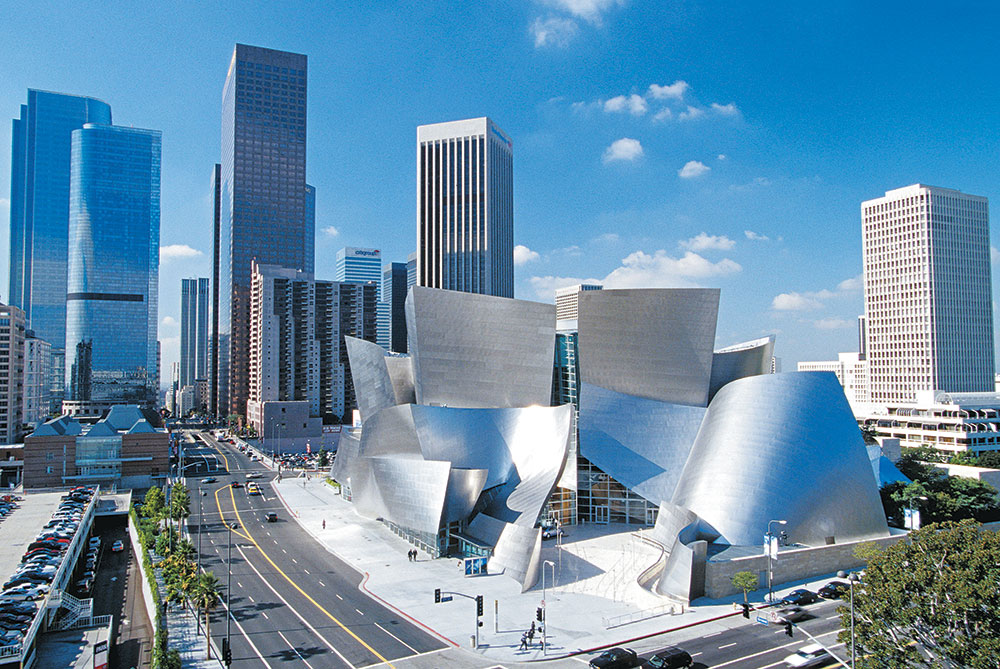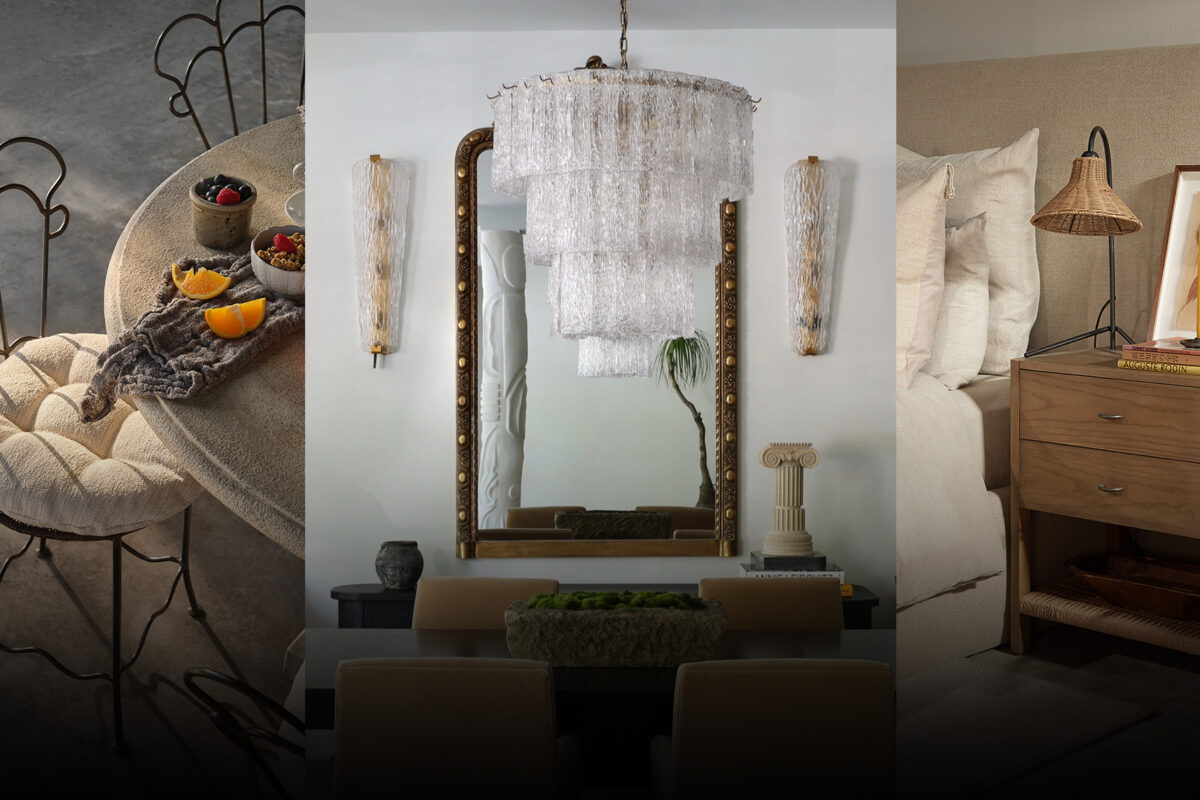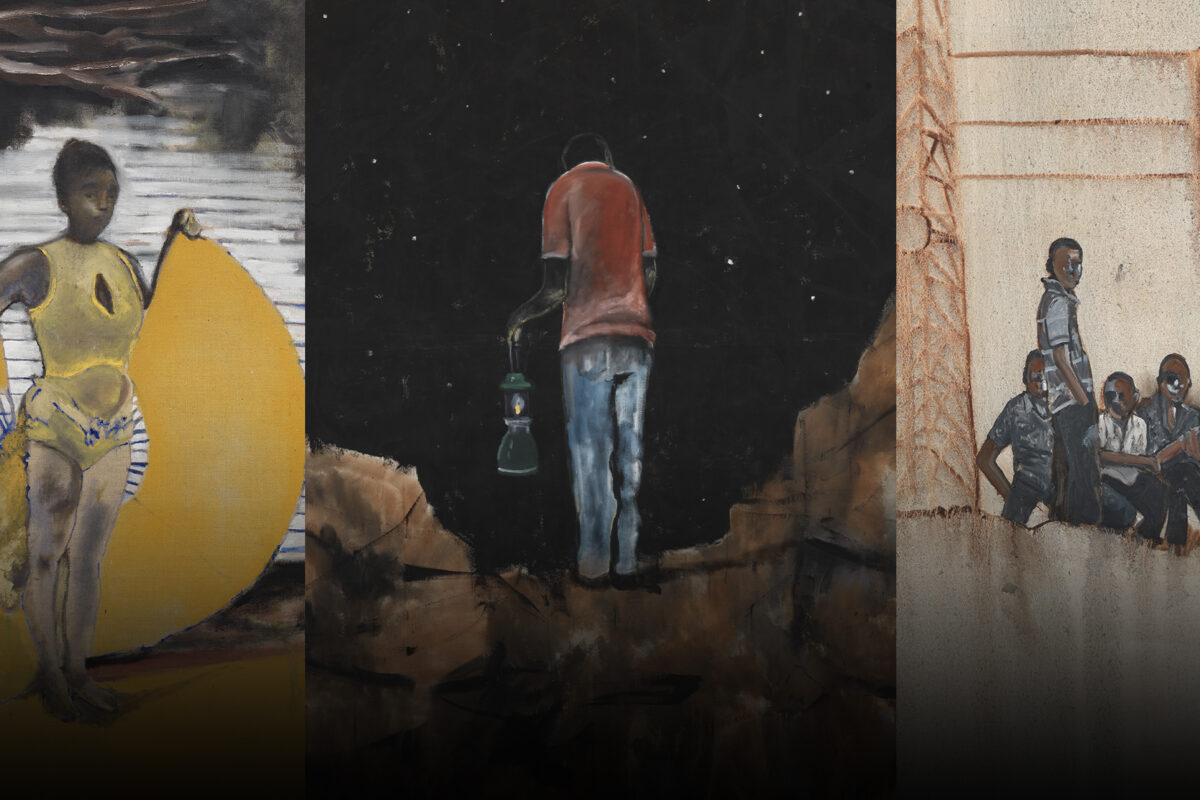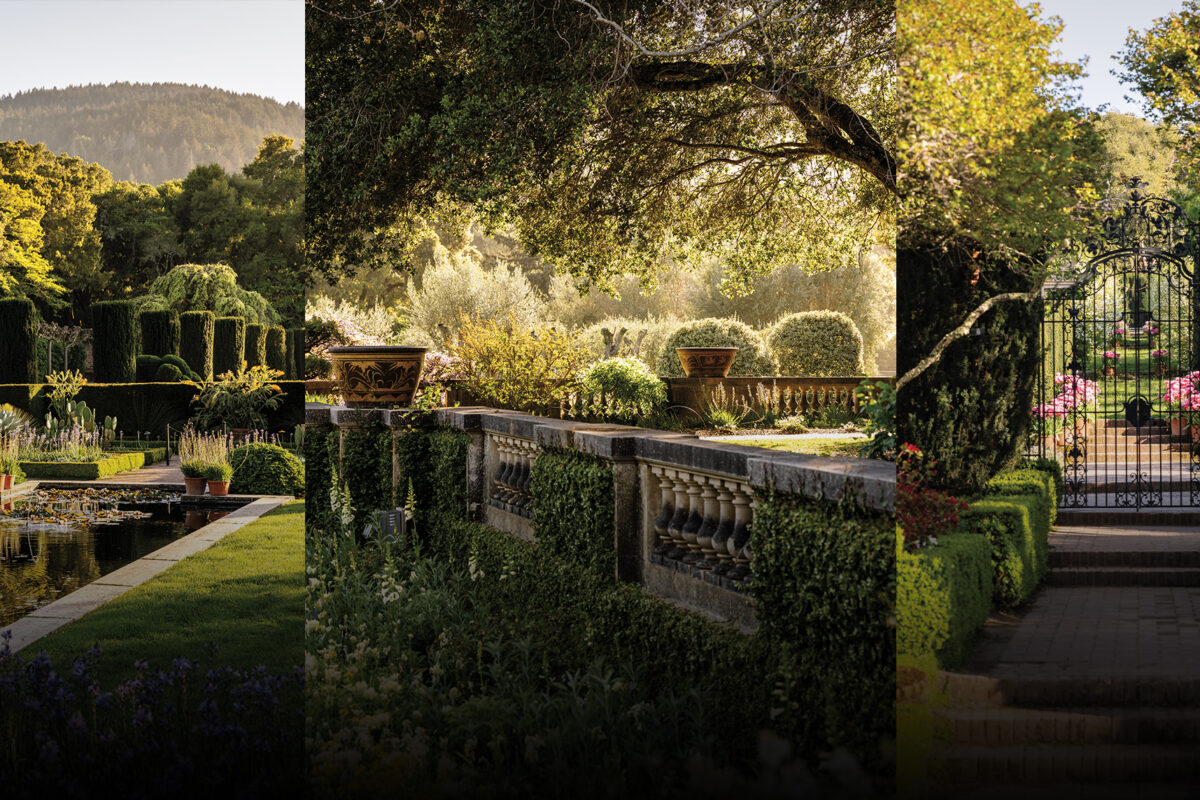On a visit to his Playa Vista headquarters, America’s most famous architect reveals the plans for his boldest project yet: L.A.
Words by PETER DAVIS
Photography by SAM FROST
Produced by DEBORAH McLEOD
 At 89, Frank Gehry is a superhero in the world of architecture, design and sculpture. Yet, using the F-bomb to make his point, Gehry has publicly denounced the label “starchitect.” He loathes the term. He sees himself as a regular guy, albeit one who has revolutionized his industry.
At 89, Frank Gehry is a superhero in the world of architecture, design and sculpture. Yet, using the F-bomb to make his point, Gehry has publicly denounced the label “starchitect.” He loathes the term. He sees himself as a regular guy, albeit one who has revolutionized his industry.
Acclaimed late architect Philip Johnson spoke for many when he called Gehry “the greatest architect we have today.” If further proof were needed, here’s the ultimate confirmation: Gehry voiced his own character on The Simpsons in 2005, lampooning himself with an alter ego who drew inspiration for a new building from a crumpled ball of paper on the ground.
The icon’s star power shows no signs of dimming as he approaches his ninth decade. Small in stature and unassuming in a Nike T-shirt and casual pants when he shows up to work at the massive, warehouse-style headquarters of Gehry Partners in Playa Vista, he is many things at once: sweetly humble with a childlike curiosity that makes him seem a decade younger, and also brave and often brash, offering his opinion with no regrets. Sitting on a plywood chair of his own design, he’s soft-spoken—except when excitedly holding forth on President Donald Trump (“he’s a nutcase”) or the red tape wrapped around green living (“being green, low-cost [housing]—all of those things are technical issues and social issues”). His personality not only fills the room, it amplifies it.
Gehry’s second-floor office, stocked with art, design and architecture books, overlooks a sea of employees and hundreds of models of iconic buildings he has designed (Walt Disney Concert Hall in Los Angeles and Spain’s Guggenheim Museum Bilbao, to name just a couple) and those he is in the midst of working on. As he leans over the railing and looks out at the workspace, his slight hunch vanishes and he stands tall, like a ruler overseeing his empire.
With a mind that is always racing, it’s almost impossible for the architect to stay idle. Listening to live classical music and sailing are two of the only ways he can slow down. He religiously goes to the office six days a week, enjoying Saturdays the most. “I like hanging out here then because it’s quiet and a few stragglers want to play,” he says sounding more like a kid who’s excited about a video game.
These days, there’s a lot on the drawing board. One of his most ambitious and challenging projects is his vision for the L.A. River, which has the potential to turn a 51-mile stretch of waterway into a public space that could become the city’s very own Central Park. The project has been stop-and-go from the start and Gehry is not in it for a paycheck. “This is just pure philanthropy,” he stresses, tapping a finger on the table. “I’m a volunteer.”
After observing the success of Manhattan’s High Line, which transformed a rusty elevated freight rail line into a heavily trafficked garden walkway, Gehry’s initial proposal is to create a 3-mile park on a platform over the river channel that runs through the communities around South Gate. Over the past few years, he met with the mayors of all the neighboring communities to get them on board. “No one had done that,” he says proudly. “Once they knew they were being thought of as partners in crime, they stepped up and wanted to play. If we do it right, the stars will align.”
A fervent and generous philanthropist, Gehry envisions the L.A. River, which is owned by the county, as a way to heal and breathe life into neglected and poor neighborhoods. “The river goes through a lot of neighborhoods where there is no open space, where the kids are not getting good playgrounds and they are underprivileged—and their lifespan is less because of it,” he says. “You combine that with the 710 freeway and the fumes and you have a real mess from a public health standpoint.” Gehry’s proposal for the 3-mile section will probably not only benefit the locals, it will add to the cultural landscape of the city as a whole. He’s talking to the Los Angeles County Museum of Art about installing an outpost there, as well as low-cost housing builders who are interested in becoming involved; Youth Orchestra Los Angeles wants in, too. “If you build a YOLA center in South Gate or along the river, you would recruit the musicians, the kids from the neighborhood; they would all be local. It doesn’t have to be a concert hall, but it would be a great venue,” says Gehry, who also designed the new 25,000-square-foot Judith and Thomas L. Beckmen YOLA Center in Inglewood (construction is slated to begin next year).
Gehry, a father of four, has always been dedicated to education, starting decades ago when he’d volunteer at elementary schools, mostly in Venice and Downtown. He would haul in cardboard boxes and paint, then instruct the students to build a city. “Once they started, they got into it. I’d say in about a half an hour, I had them in. We would sort of simulate a city and [talk] about what the city was all about. Once I got their attention, you could talk about civics, who runs the city, art—you could talk about everything. It was wide open. You just needed to get them off this rigid school curriculum,” he says.
Today, Gehry is committed to Turnaround Arts, an organization started by Michelle Obama in 2011 to bring arts education to underprivileged schools. Gehry co-founded the nonprofit’s dedicated California branch in 2014. “[Turnaround Arts invests] $100,000 per year, per school,” he explains before adding with a big sly grin, “I got [Mark] Zuckerberg to pledge $100,000.”
The architect is equally passionate about green living. His new house in Santa Monica is nearly off-grid. “We [he and wife Berta Isabel Aguilera] have nine geothermal wells. We spent more money saving energy than we will ever realize on the return,” Gehry says. “I wanted to see how nuts it got and where it could go…to see what makes sense in the future.”
He says he doesn’t believe in the LEED (Leadership in Energy and Environmental Design) program, which is the most widely used green building rating system on the planet. “Some of them work, some of them don’t,” he says, shaking his head, implying that some buildings deserve to be cited for being energy-efficient, whereas others are sort of faking it to get a LEED certificate. “That’s become a mantle, and you buy [an LEED house] and you get a star and you’re free.” Gehry grimaces at the idea of not being fully committed to going green, no matter what the cost. “I’ve always felt someone is making money off that game of giving certification.”
He also struggles with the economic hurdles of building low-cost housing and new schools, two issues that matter deeply to him. “If you’re running a business office, you can’t afford to do them,” he laments with a shrug. “So you have to do them as philanthropy. Up until recently, I couldn’t afford that. Now I can do it, and I’m doing it quite a bit. The developer [Thomas] Safran is an angel in that department. He’s the guy I want to work with on the L.A. River. We should all be doing it,” he declares, a call for the world to support low-cost housing projects.
The lack of feasible low-cost housing and green living leads Gehry to the current Trump administration. He sits up straighter, as if addressing an audience. “I have spoken up,” he declares. “I do know the man who is president. I’ve met him. I have no idea where this ends. But it’s scary. It’s really scary. What’s scary is how many people support him.” He pauses and rubs his chin, his eyes closing for a few seconds. “He’d be better as an artist. He could make things, be outrageous and be a positive force that way. We could call him ‘Trump L’Oeil.’”
Gehry understands the challenges of growing up in poverty firsthand. He was born Ephraim Owen Goldberg in Toronto, and changed his name to avoid anti-Semitism. When asked about his childhood, he responds, “That’s not a nice story,” before elaborating. “My father lost everything. He didn’t have that much, but whatever he had, he lost. His brother was driving to California and [his family] scooped him up and he came out here. We were really poor. We lived on Ninth Street downtown, near the [food] pantry.” As a teenager, Gehry found a job as a truck driver. “[Those were] rough times. Somehow we made it out. I’ve been here since ’47. Now it’s home.”
He attended the University of Southern California on a scholarship, where he studied architecture and flourished. The architecture school was then in the same building as the art department and Gehry bonded with the art students more than his fellow classmates, who he found to be rigid in their ideology.
In 1964, when he did one of his first buildings on his own (a residence and studio for graphic artist Lou Danziger on Melrose Avenue), he met the then-famous artist Ed Moses, who was a friend of Danziger’s and just happened to be at the construction site. Moses invited Gehry into his rarefied world of artists. He immediately felt at home.
“The architects were saying things that didn’t make any sense to me,” Gehry remembers of the late ’60s. “They were talking about rules of engagement…it had to be this way and if you didn’t straighten this wall, it would not be minimal enough, not pure enough. They were talking all that funny stuff which made no sense at all.”
So instead Gehry hung around the likes of Ed Ruscha, Larry Bell, Chris Burden and Jasper Johns. “I’ve always thought that architecture was an art, historically. [But] I never wanted to claim that. There was such a stigma attached to it. ‘I’m an artist’—that’s saying I’m better than you…When anybody asked what I was doing, I said, ‘I’m an architect.’ It was kind of a protective coating, so I didn’t have to get into the discussion. But I hung out with the people I loved and I felt more comfortable with them and vice versa—they included me in everything. They all think of me as one of the artists.”
Larry Gagosian, Gehry’s longtime friend and art dealer, understands why Gehry is so attracted to painters and sculptors and not other architects. “Architects are extremely competitive,” he says. “It would be odd for all your best friends to be architects. I think he’s more comfortable with artists because it’s more refreshing to be around people who aren’t dealing with the same stuff you’re dealing with at the same time.”
Gehry’s most famous buildings—the Nationale-Nederlanden Building (aka “Dancing House”) in Prague, the Fondation Louis Vuitton in Paris, the Walt Disney Concert Hall and the Guggenheim Museum Bilbao—are really large-scale, functional sculptures crafted from unexpected, visually exciting materials such as corrugated metal, chain-link fencing and titanium. The Guggenheim Bilbao was so successful in reviving the Basque city, that the building’s international draw has become known as the “Bilbao Effect.” Gehry remembers the first time he saw his nearly completed project in Bilbao. “It scared the s— out of me,” he confesses, and then laughs. “I came over the hill. I saw it there and I thought, ‘Oh, my God. What have I done to these poor people?’ I really did. There’s a kind of embarrassment—it’s your ego thing and you’re imposing it.” He pauses and smirks. “I got over it.”
Gehry’s work extends beyond the realms of philanthrophy and architecture. Take his signature Fish Lamps, which have been exhibited around the globe since the 1980s, including at Gagosian galleries. He became obsessed with fish years ago when he gave a talk on the East Coast. “It was a time when architects were turning to historicism and they were calling it postmodernism. And I was upset with that. It was like a disease. Everyone did it in what seemed like a week,” he recalls without a trace of irony. “I said, ‘Greek temples are anthropomorphic. Fish are [hundreds of millions of] years before that, before man. Why don’t we get excited about fish?’ And after that talk, it stayed in my head and I started drawing fish and I made the Fish Lamps.”
The lamps—made with Formica Color-Core and steel frames on wooden bases—first gained momentum at a party with a lot of heavy hitters, after someone unwrapped one of the pieces as a gift. The next morning, S.I. Newhouse called asking to buy one, as did Philip Johnson and Jasper Johns. “It was hilarious. I didn’t know what to do with all this. Larry Gagosian was around and I showed him this stuff. And Larry, God bless him, said, ‘Make a bunch of them and I’ll show it.’ And he did and he sold it out in a couple of weeks—and that started it.”
Gagosian remembers that first show well. “I had a vision of displaying these in a darkened gallery space and you walk in and you see these lamps glowing in the space—I thought it would be a very seductive presentation and it certainly was,” Gagosian says. “They are really beautiful. They’ve worn well over time, which is one of the most important tests of art. How does it look five years later, 10 years later, 20 years later? They are as captivating now as when he first made them.”
Gagosian recently approached Gehry about doing a show of historical Fish Lamps in Paris, timed with the Fondation Louis Vuitton’s opening, but Gehry decided to make new stuff instead. He made a bear, a crocodile and a special horse for LVMH. And, of course, lots of fish, but designed in new ways.
Though he has an iPhone by his side and an Apple Watch strapped to his wrist, Gehry prefers to avoid computers and starts projects by sketching, often at home, then building countless models with his team. He has a 60,000-square-foot warehouse in Carson filled with models. “The Getty just acquired a bunch of stuff from us,” he says with relief. “We still have more. I don’t know what to do with it.” Gehry likes making models because it’s a way to collaborate with his team, many of them young architects. “You can feel when it’s not going right so you can derail it and start and stop and then it clicks somehow.”
“The kind of work Frank does is almost like play,” Gagosian says. “New challenges and new buildings pull him forward and energize him.” In addition to the L.A. River project and numerous other buildings, he is working on a real estate development on Grand Avenue, across from the Walt Disney Concert Hall, that will literally create a new neighborhood with lots of public space. “It was hard, because you can’t talk to developers about the art of architecture,” he groans. “It took a while. But the staggering [in securing funding and having the project approved] helped us get to know the people and feel more comfortable. And the developers are starting to see that cultural thing, so they’re starting to look at it that way.” Like his now-iconic Disney Hall, Gehry hopes to include another concert venue in the ambitious project. Just this year, after a battle with local preservationists, his mixed-use project at 8150 Sunset Blvd. got the green light and will replace the zigzag-roofed Lytton Savings bank building, which was designed by modernist Kurt Meyer. Once again, Gehry’s vision will change the skyline of Los Angeles.
After more than an hour and a half of talking about his life and career, Gehry starts to shift in his seat. He gets up and again leans over the iron railing that overlooks his massive, buzzing studio, walls covered with art, workers on laptops or building models. “It’s time to get back to work,” he announces, with a smile, and bolts down the stairs.
Feature image: THE WALT DISNEY CONCERT HALL, designed by FRANK GEHRY.
This story originally appeared in the October 2018 issue of C Magazine.
Discover more DESIGN news.






